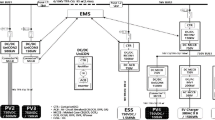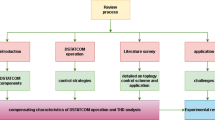Abstract
Microgrid (MG) is not only undergoing rapid upsurge and an effective combination of distributed generations (DGs)-based renewable energy sources, but it also fulfills a significant function in upgrading grid infrastructure. It is necessary for DGs, during and after any disturbances in the voltage, to stay connected in order to enhance the voltage, most importantly guaranteeing the stability of the power system. In this present context, the behavior of the distributed generations control systems has a significant impact on the MG performance. This paper investigates the effect of different control schemes of the inverter-based DG unit on the stable operation of MG after the occurrence of faults that lead to islanding events. In this paper, an appropriate control strategy is proposed to enhance the fault ride-through of MG. Within the scope of the study, the MG consists of a conventional diesel generator and an inverter-based DG unit. The MG also contains several load types; RLC load as a static load and induction motor as a dynamic load. The MATLAB Simulink is used to model the MG and its inverter control schemes. In order to assure MG stability, the variations of the voltage and frequency are possessed as key references. Results indicate that the control strategies of the inverter have a strong influence on the stability of MG. Moreover, the MG configuration with the proposed FRT resists fault effects for longer durations and this enhances the stability.













Similar content being viewed by others
References
Dsilva S, Shadmand M, Bayhan S, Abu-Rub H (2020) Towards grid of microgrids: seamless transition between grid-connected and islanded modes of operation. IEEE Open J Ind Electron Soc 1:66–81
Zia MF, Benbouzid M, Elbouchikhi E, Muyeen SM, Techato K, Guerrero JM (2020) Microgrid transactive energy: review, architectures, distributed ledger technologies, and market analysis. Energy Procedia IEEE Access 8:19410–19432
Shuai Z, Sun Y, Shen ZJ, Tian W (2016) Microgrid stability: classification and a review. Renew Sustain Energy Rev 58:157–169
Olivares E, Mehrizi-Sani A, Etemadi AH (2014) Trends in microgrid control. IEEE Trans Smart Grid 5(4):1905–1919
Rokrok E, Shafie-Khah M, Catalão JPS (2018) Review of primary voltage and frequency control methods for inverter-based islanded microgrids with distributed generation. Renew Sustain Energy Rev 82:3225–3235
Interconnecting Committee (2003) IEEE Standard for Interconnecting Distributed Resources With Electric Power Systems. IEEE Standard 1547, pp 1–28. https://scholar.google.com/scholar?hl=en&q=IEEE+standard+for+interconnecting+distributed+resources+with+electric+power+systems%2C+IEEE+Std.+1547-2003%2C+2003
IEEE guide for design, operation, and integration of distributed resource island systems with electric power systems, IEEE Std 1547.4-2011 (2011), pp 1–54. https://scholar.google.com/scholar?hl=en&q=IEEE+guide+for+design%2C+operation%2C+and+integration+of+distributed+resource+island+systems+with+electric+power+systems%2C+IEEE+Std.+1547-4-2011%2C+2011
E.ON. Netz Gmbh, Germany (2006) Grid code regulations for high and extra high voltage. status. Report ENENARHS2006. https://www.eon-netz.com. https://scholar.google.com/scholar?oi=gsb40&q=Grid%20code%20regulations%20for%20high%20and%20extra%20high%20voltage%2C%20E.ON.%20Netz%20Gmbh%2C%20Report%20ENENARHS2006.%20status%3A%20Germany%2C%20(2006).&lookup=0&hl=en
Bak-Jensen B, Kawady TA, Abdel-Rahman MH (2010) Coordination between fault-ride-through capability and over-current protection of DFIG generators for wind farms. J Energy Power Eng 4(4):20–29
Salem AA, Alaboudy AHK, Abdelsalam AA, Talaat HEA (2019) Incorporating switched modulated power filter compensator to enhance the microgrid performance under fault provoked islanding conditions. Electr Power Compon Syst 47(22):1046–1059
Katiraei F, Iravani MR, Lehn PW (2005) Micro-grid autonomous operation during and subsequent to islanding process. IEEE Trans Power Deliv 20(1):248–257
Salem AA, Alaboudy AHK, Abdelsalam AA, Talaat HEA (2016) Dynamic performance of microgrid after fault provoked islanding considering Induction Motor loads. In: 2016 IEEE international Middle East power systems conference (MEPCON), Cairo, Egypt
Gkavanoudis SI, Demoulias CS (2014) A combined fault ride-through and power smoothing control method for full-converter wind turbines employing super capacitor energy storage system. Electr Power Syst Res 106:62–72
Worku MY, Abido MA (2019) Fault ride-through and power smoothing control of PMSG-based wind generation using super capacitor energy storage system. Arab J Sci Eng 44:2067–2078
PCS 6000 STATCOM to Compensate Long Power Line With Heavy Load, Feb 2010. http://www.abb.com
Lee DC (1992) IEEE recommended practice for excitation system models for power system stability studies (IEEE Std 421.5-1992). Energy Development and Power Generating Committee of the Power Engineering Society. https://scholar.google.com/scholar?hl=en&q=Recommended+practice+for+excitation+system+models+for+power+system+stability+studies%2C+IEEE+St.+421.5%2C+Aug.+1992
Brabandere KD, Bolsens B, Keybus JVD, Woyte A (2007) A voltage and frequency droop control method for parallel inverters. IEEE Trans Power Electron 22(4):1107–1115
El Moursi MS, Xiao W, Kirtley JL (2013) Fault ride through capability for grid interfacing large scale PV power plants. IET Gener Transm Distrib 7:1027–1036
Author information
Authors and Affiliations
Corresponding author
Additional information
Publisher's Note
Springer Nature remains neutral with regard to jurisdictional claims in published maps and institutional affiliations.
Appendix
Appendix
1.1 Data of microgrid components
Base values Base MVA = 1 MVA, base voltage = 480 V Utility data at 34.5 kV bus: MVAsc = 100 MVA and X/R = 10 |
Transformer 3 MVA, 34.5 kV/480 V, Yg/Δ, 60 Hz Resistance and inductance at the HV side: 0.00083, 0.025 pu Resistance and inductance at the LV side: 0.00083, 0.025 pu |
Inverter control parameters For P–Q control scheme Kp = 0.05, Ki = 40 Current loop Kp = 5.25, Ki = 1000 For current injected control scheme Current loop Kp = 5.25, Ki = 1000 |
Filter impedance Zf = 0 + j0.25 pu |
DC voltage source Vdc = 1000 V |
Synchronous generator Nominal power: 0.75 MVA, Salient pole Nominal L–L voltage: 480 V Nominal frequency: 60 Hz Number of poles: 4 Stator resistance R s: 0.003 pu Leakage reactance Xl: 0.18 pu Direct axis reactance Xd: 1.305 pu Transient direct axis reactance X’d: 0.296 pu |
IM loads Comprised of three identical machines; the parameters for each machine Nominal power: 149.2 kVA (200 HP); squirrel cage rotor Nominal L–L voltage: 480 V Nominal frequency: 60 Hz No. of poles: 4 Stator resistance (Rs): 0.01982 Ω Stator inductance (Lls): 0.207 mH Rotor resistance (R′r): 0.0109 Ω Rotor inductance (L′lr): 0.207 mH Mutual inductance (Lm): 10.3 mH Moment of inertia: 3.1 kg m2 Friction factor: 0.048 Nms |
1.2 Matlab simulink models
Microgrid model:

Synchronous based DG:

Inverter-based DG:

Droop control-PQ scheme.

Droop control-current injected scheme;

Rights and permissions
About this article
Cite this article
Alaboudy, A.H.K., Salem, A.A. & Abdelsalam, A.A. An efficient fault ride through capability for integrating inverter-based DG with microgrid to enhance the transient response. Electr Eng 104, 3091–3105 (2022). https://doi.org/10.1007/s00202-021-01442-y
Received:
Accepted:
Published:
Issue Date:
DOI: https://doi.org/10.1007/s00202-021-01442-y




